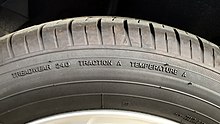

Uniform Tire Quality Grading, commonly abbreviated as UTQG, is a set of standards for passenger car tires that measures a tire's treadwear, temperature resistance and traction. The UTQG was created by the National Highway Traffic Safety Administration in 1978, a branch of the United States Department of Transportation (DOT).[1] All passenger car tires manufactured for sale in the United States since March 31, 1979 are federally mandated to have the UTQG ratings on their sidewall as part of the DOT approval process, in which non-DOT approved tires are not legal for street use in the United States. [2] Light truck tires are not required to have a UTQG. It is not to be confused with the tire code, a supplemental and global standard measuring tire dimensions, load-bearing ability and maximum speed, maintained by tire industry trade organizations and the International Organization for Standardization.
The National Highway Traffic Safety Administration (NHTSA) established the Uniform Tire Quality Grading Standards (UTQGS) in 49 CFR 575.104.[3] When looking at UTQG ratings it is important to realize that the Department of Transportation does not conduct the tests. The grades are assigned by the tire manufacturers based on their test results or those conducted by an independent testing company they have hired. The NHTSA has the right to inspect tire manufacturers' data, and can fine them if inconsistencies are found.
The NHTSA published DOT HS 812 325 “Consumer Guide to Uniform Tire Quality Grading” August 2016, which provides rating information. [4]
Dedicated winter tires, also known as snow tires, are not required to have a UTQG rating.[5] Non-passenger car tires, such as those for motorcycles, buses, medium trucks and above along with trailers are also not required to have a UTQG rating, although FMVSS Standard 109 requires the following to be listed on the tire's sidewall: speed restriction if less than 55 mph, regroovable if designed for regrooving, and a letter designating load range rating.[6]
- ^ "The Grand History and Evolution of UTQG – Part II". January 28, 2011.
- ^ "UTOG CHRONOLOGY". Rubber & Plastics News. Retrieved August 6, 2016.
- ^ "49 CFR 575.104 - Uniform tire quality grading standards". Cornell University Law School. Retrieved August 6, 2016.
- ^ "Consumer Guide to Uniform Tire Quality Grading" (PDF). www.nhtsa.gov. Retrieved May 9, 2019.
- ^ "Understanding the UTQG car tire-grading system". Consumer Reports. Retrieved August 6, 2016.
- ^ Weiss, Sandra. "An Evaluation of the Uniform Tire Quality Grading Standards and Other Tire Labeling Requirements". www.nhtsa.gov. Retrieved May 9, 2019.